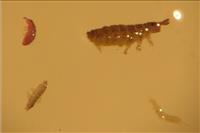
Caption: Springtails
Photo by: Doug Collins, WSU
|
|
Springtails
(revision date: 2/27/2014)
Use Integrated Pest Management (IPM) for successful pest management.
Biology
Springtails are small (1/8 inch or less), wingless insects that can be found in large numbers during very wet conditions in the fall, winter, and spring. Typically, people notice large “piles of soot” in driveways, back yards, or on the surface of mud puddles. These large piles are springtails or Collembola. These tiny insects do not bite humans, spread disease, or damage household furnishings, but they can be a nuisance simply by their presence. Springtails get their name from their ability to catapult themselves up to 4 inches by using a tail-like mechanism which they keep tucked up under their abdomen. When they sense danger, they use this device to spring away from the danger source. These moisture-loving insects can be found under boards, houseplants, pots, bark, rotten logs, mushroom beds, snow, on pool surfaces, or in any damp area that is often accompanied by shade. Springtails feed on mildew and other fungi, algae, and decaying organic matter.
|
